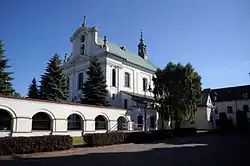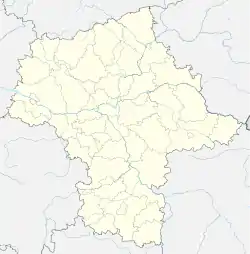Góra Kalwaria
Góra Kalwaria (pronounced Goo-rah Calvaria [ˈgura kalˈvarʲa] – Calvary Mountain) is a town on the Vistula River in the Masovian Voivodeship, in east-central Poland. It is situated approximately 35 kilometres (22 miles) southeast of Warsaw and has a population of around 12,109 (as of 2019).[1] The town has strong religious significance for both Catholic Christians and Hasidic Jews of the Ger dynasty.
Góra Kalwaria | |
|---|---|
 Catholic Church of the Immaculate Conception | |
 Flag  Coat of arms | |
 Góra Kalwaria  Góra Kalwaria | |
| Coordinates: 51°58′24″N 21°12′52″E | |
| Country | |
| Voivodeship | |
| County | Piaseczno |
| Gmina | Góra Kalwaria |
| Established | 13th century |
| Town rights | 1670 |
| Government | |
| • Mayor | Arkadiusz Strzyżewski |
| Area | |
| • Total | 13.72 km2 (5.30 sq mi) |
| Population (2019) | |
| • Total | 12,109 |
| • Density | 880/km2 (2,300/sq mi) |
| Time zone | UTC+1 (CET) |
| • Summer (DST) | UTC+2 (CEST) |
| Postal code | 05-530 |
| Area code(s) | +48 22 |
| Car plates | WPI |
| Website | http://www.gorakalwaria.pl |
History

The village of Góra already existed in the 13th century. Completely destroyed during a Swedish occupation known as the Deluge, in 1666, it became the property of Stefan Wierzbowski, Bishop of Poznań, who decided to found a new town on the ruins. His plan was to build a calvary — a religious center dedicated to passion plays and services, which was popular in the early modern Poland. He was encouraged by the fact that the local landscape resembled that of the Holy Land.
In 1670, the town was renamed Nowa Jerozolima, granted city rights and construction work kicked off. The urban design was based on medieval maps of Jerusalem, and the street grid formed a Latin cross. The bishop invited Dominican, Bernardine and Piarist orders to settle in the town, which soon became dotted with monasteries, churches, chapels and passion paths (such as stations of the Cross). The town was supposed to be a purely Christian one and Jews were not allowed to settle there.
After Bishop Wierzbowski's death the decline of the town began. Many churches and chapels were pulled down, and in the years 1883–1919 the town was deprived of city rights.
In the early 19th century, the ban on Jewish settlement was lifted and Jews shortly became the predominant group in the town. Góra Kalwaria then became one of the major centers of Hasidic Judaism and home to the Ger dynasty. During the Holocaust, the Jewish population of the town was first concentrated in a small ghetto. In 1942, it was transferred to the Warsaw Ghetto and from there to the Treblinka extermination camp.
People
- Rebbes of Ger (Alter family)
- Pinchas Menachem Justman, The Piltzer Rebbe
- Dov Berish Einhorn, The Amstover Rav
- Józef Chaciński, politician and lawyer
- Yitzhak-Meir Levin, member of the Sejm and signatory of the Israeli declaration of independence
- Wolf Messing, a mentalist
- Yankel Talmud (1885-1965), Ger court composer
External links
| Wikimedia Commons has media related to Góra Kalwaria. |
